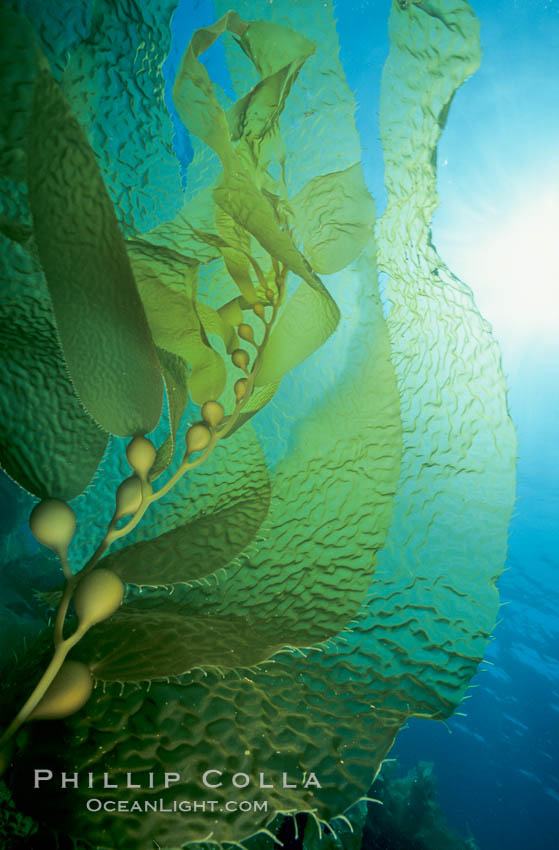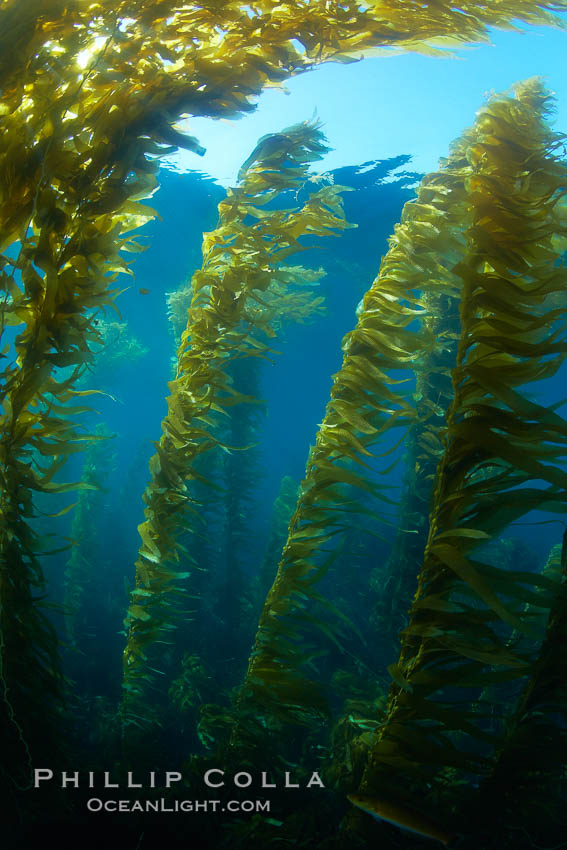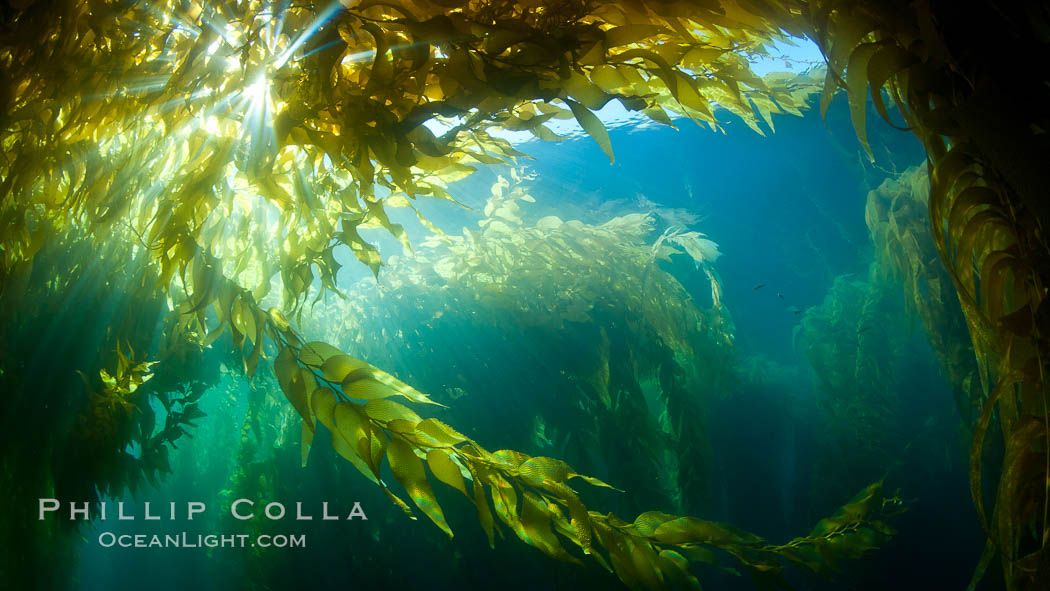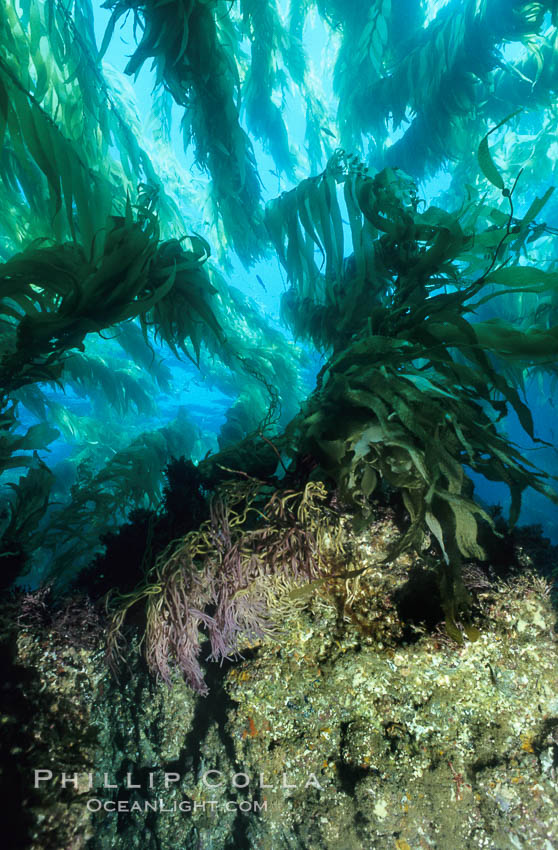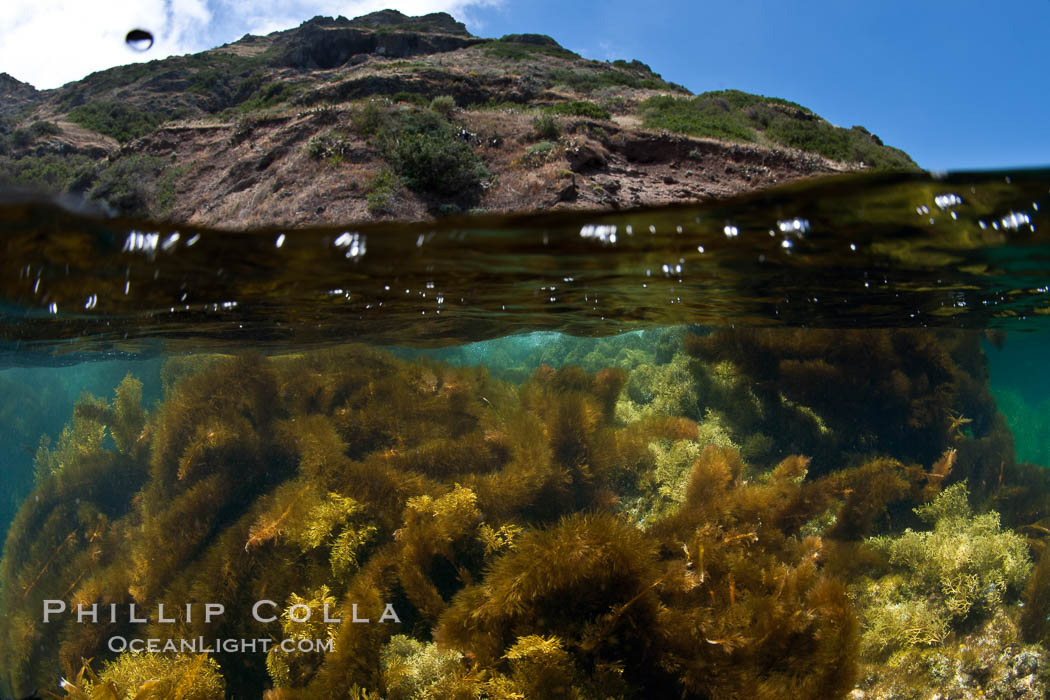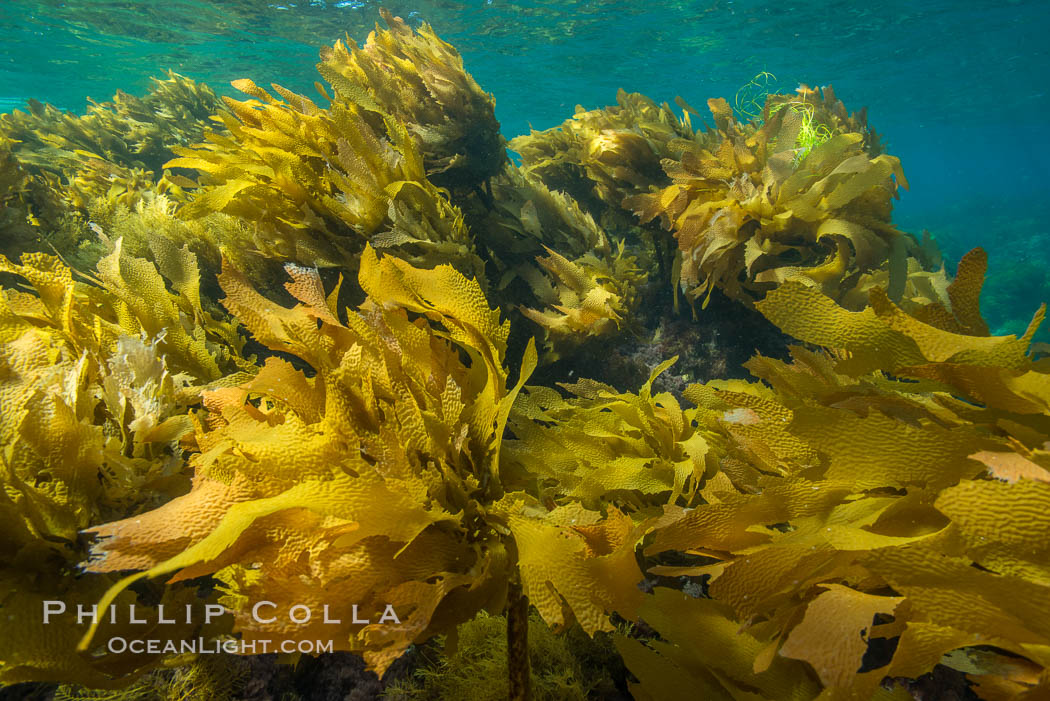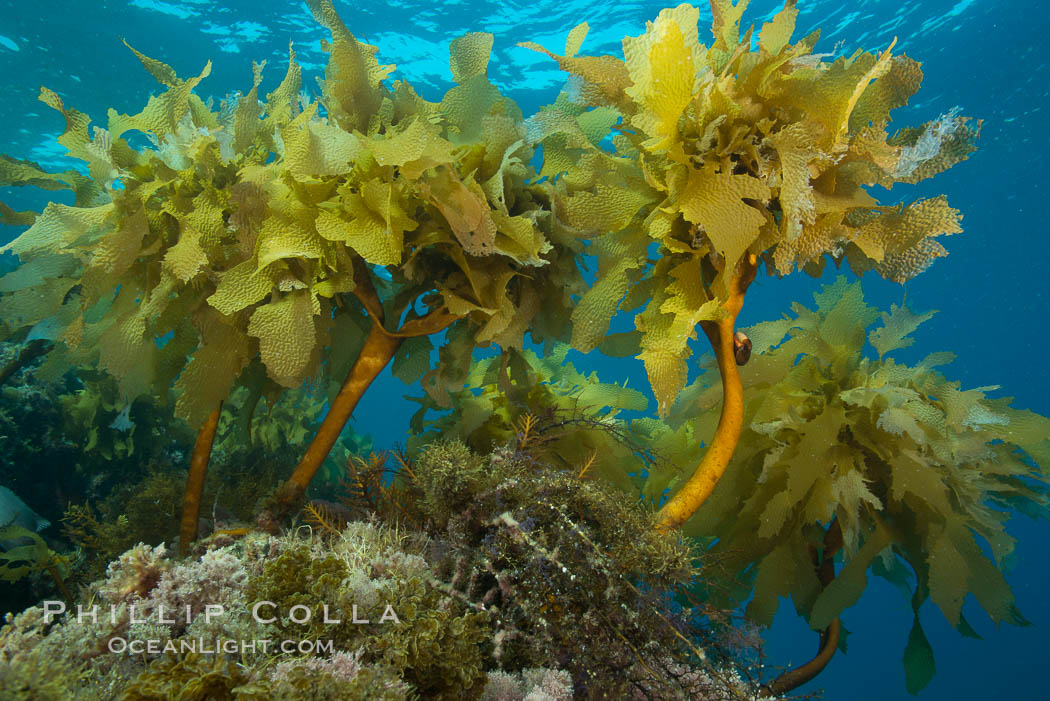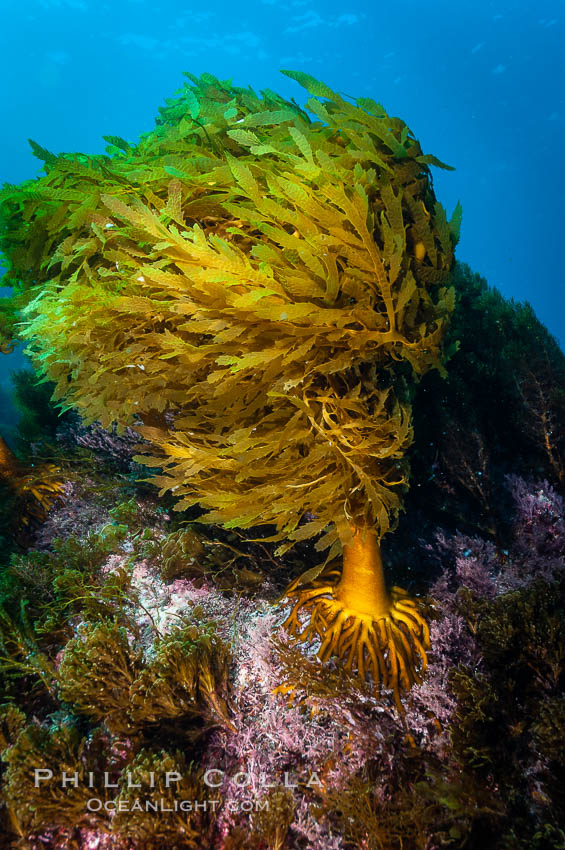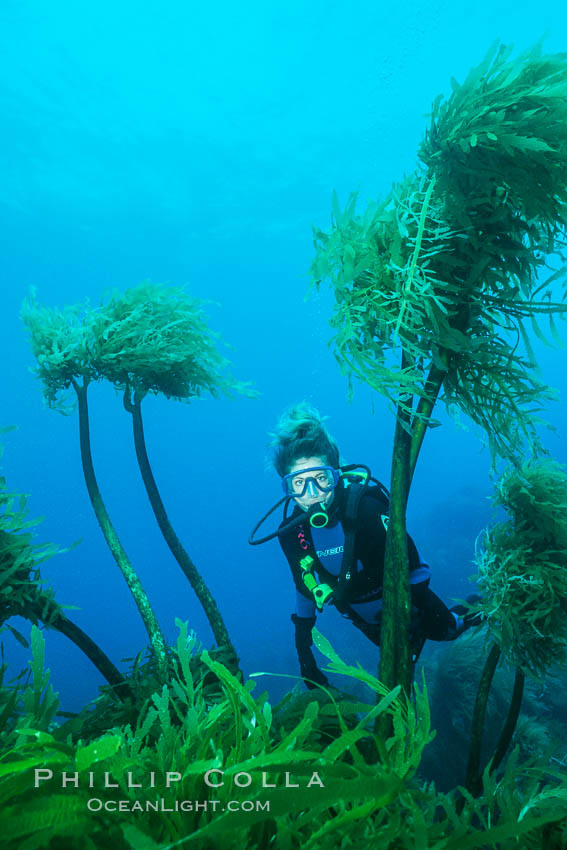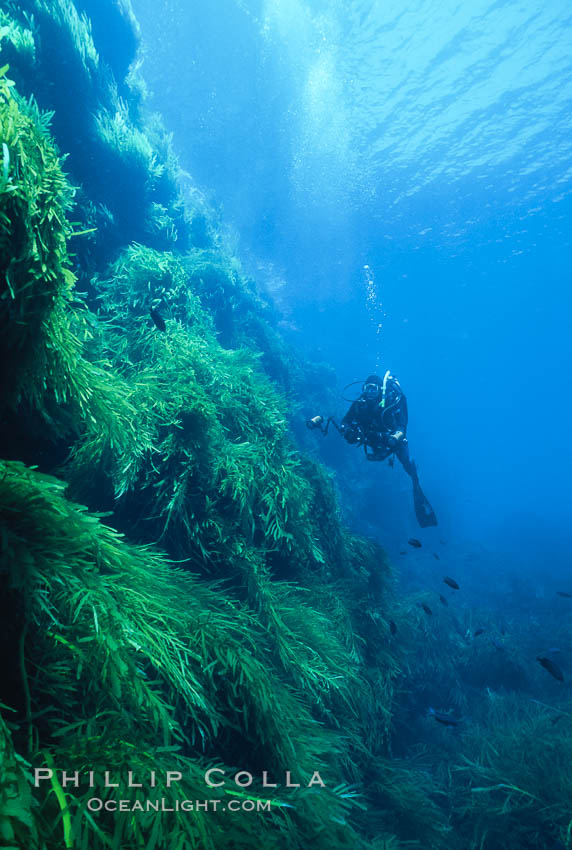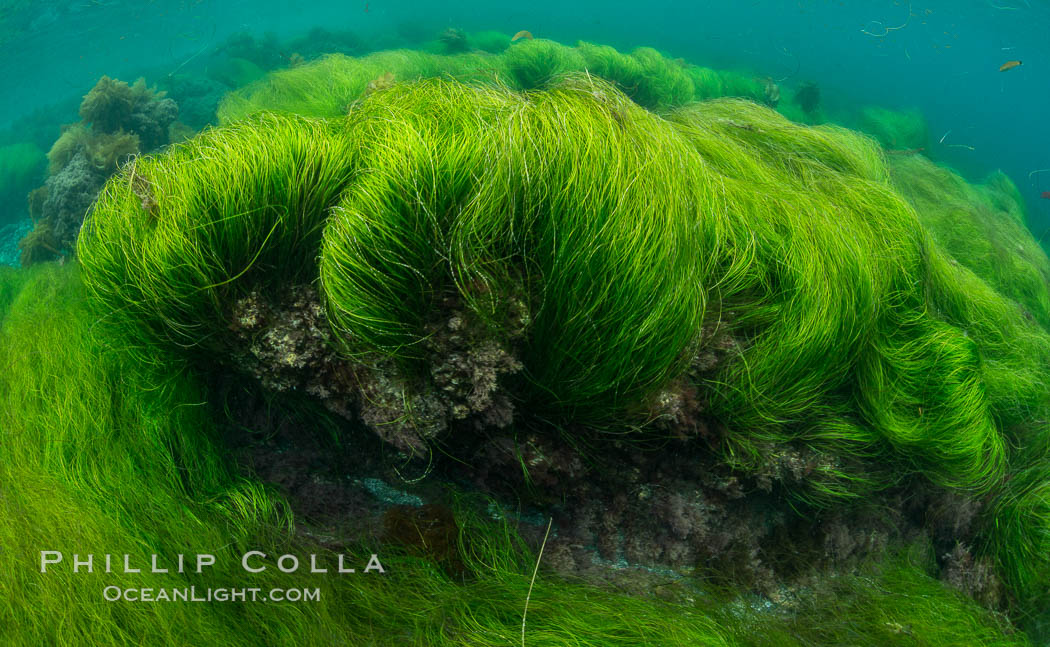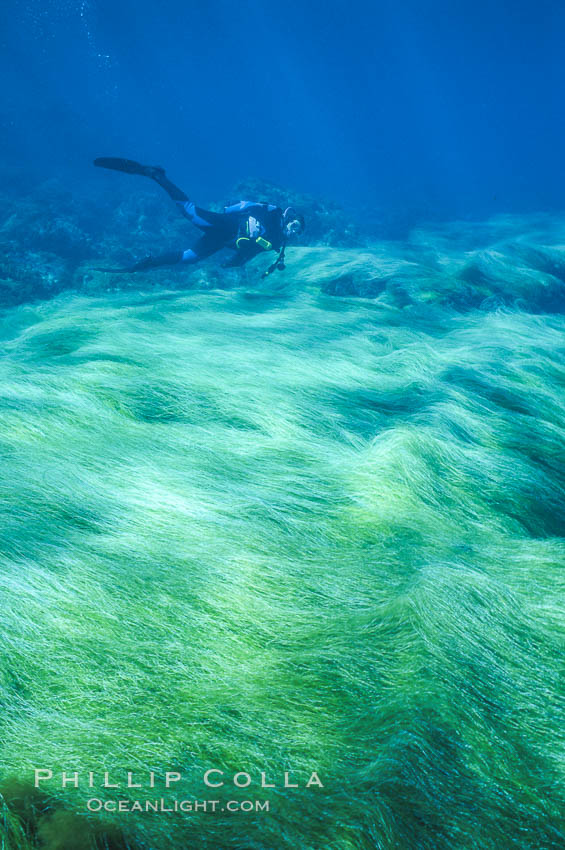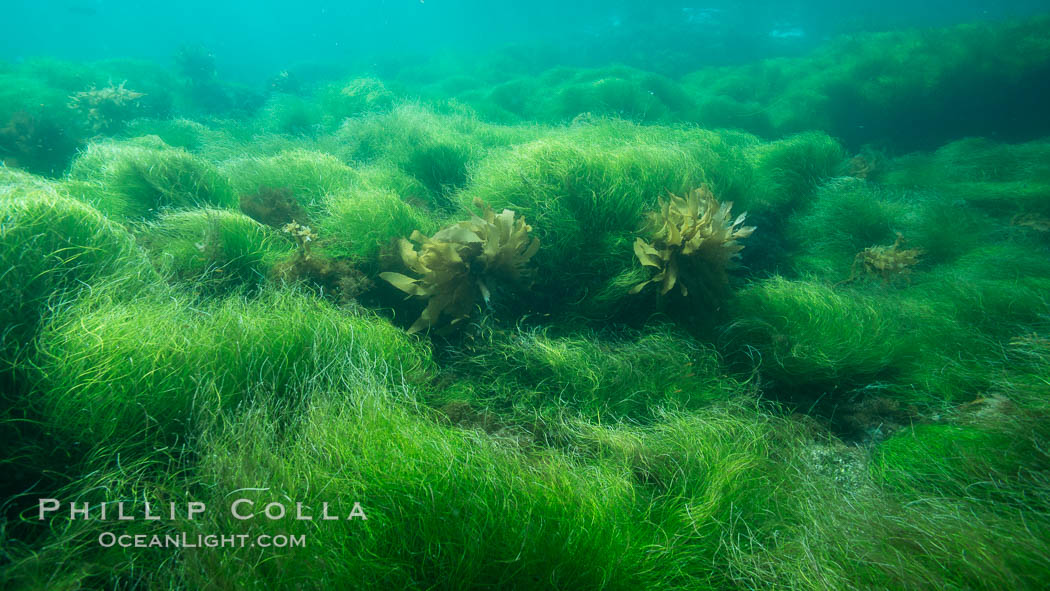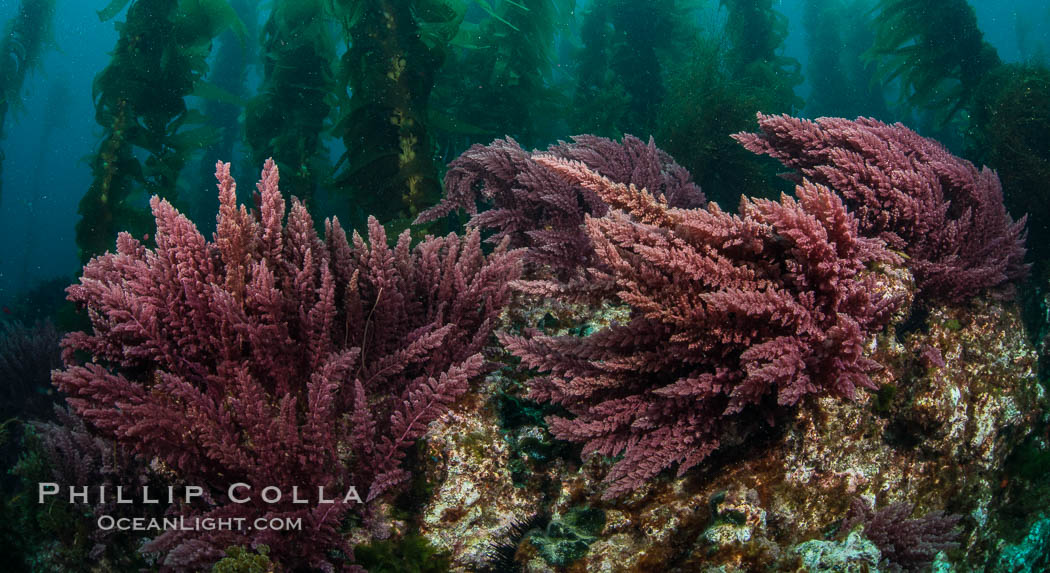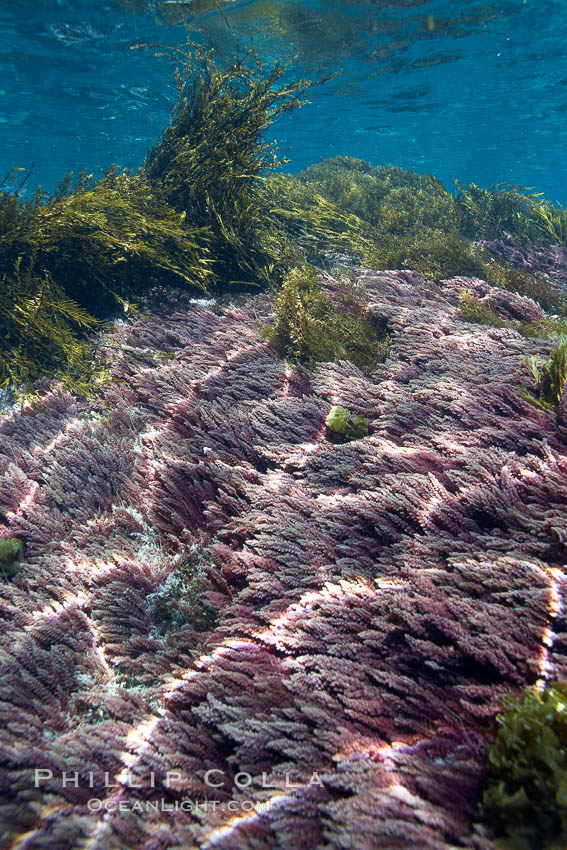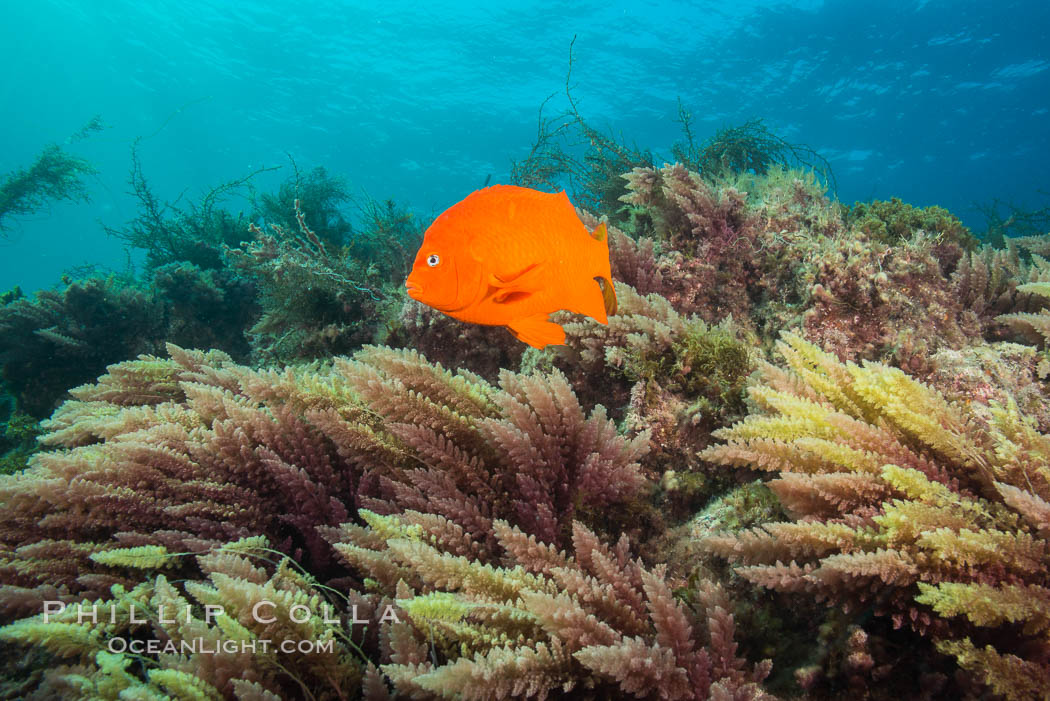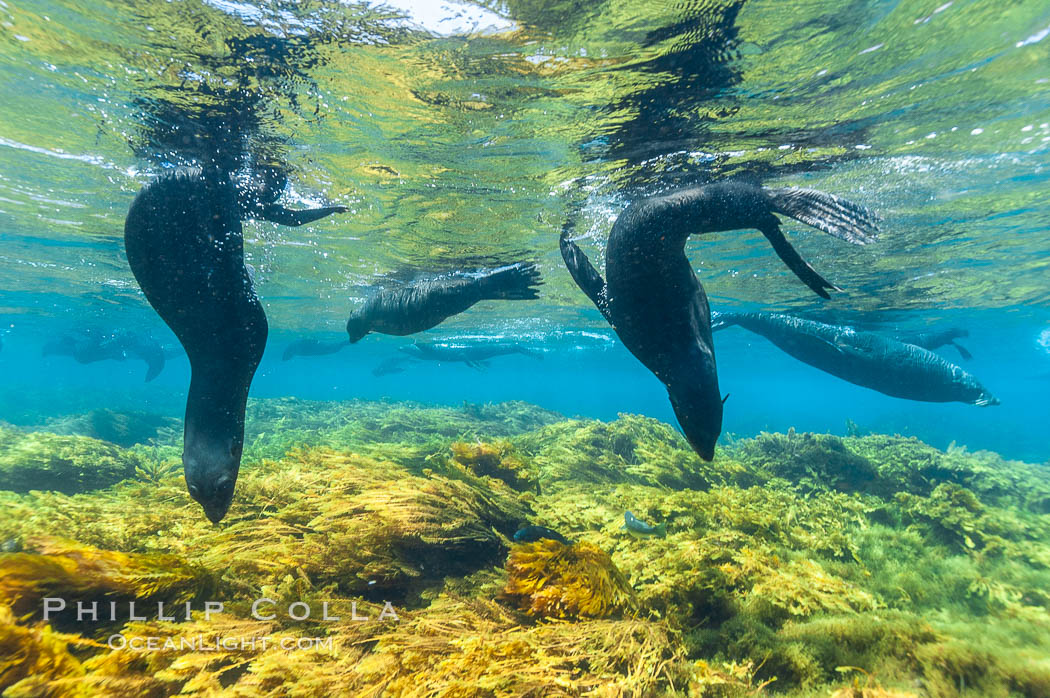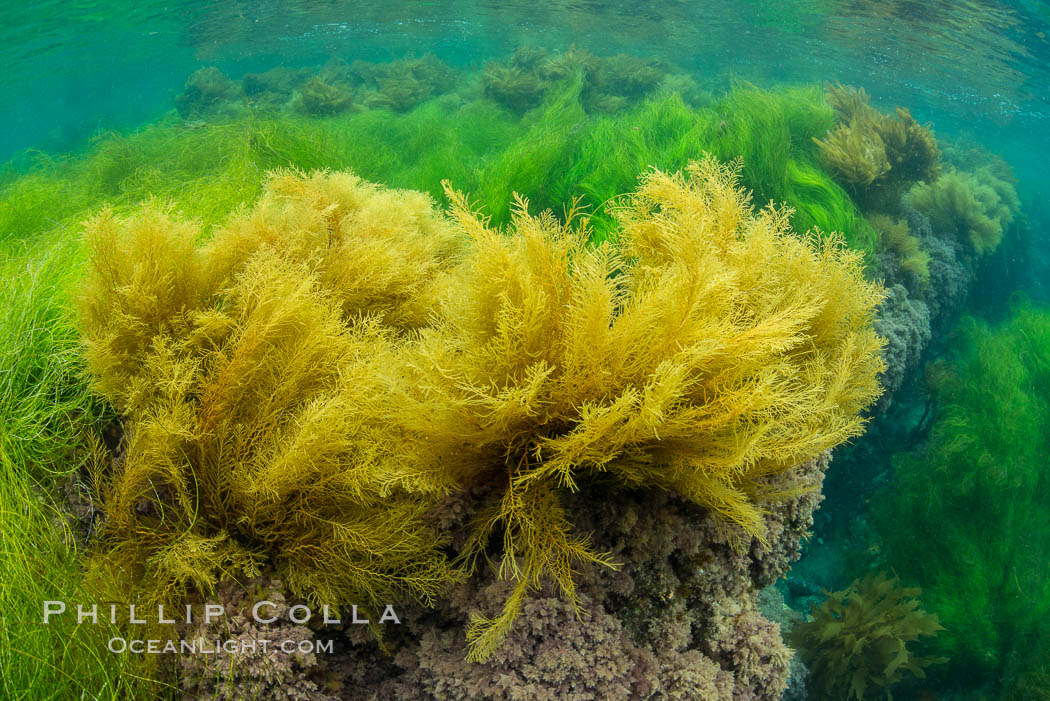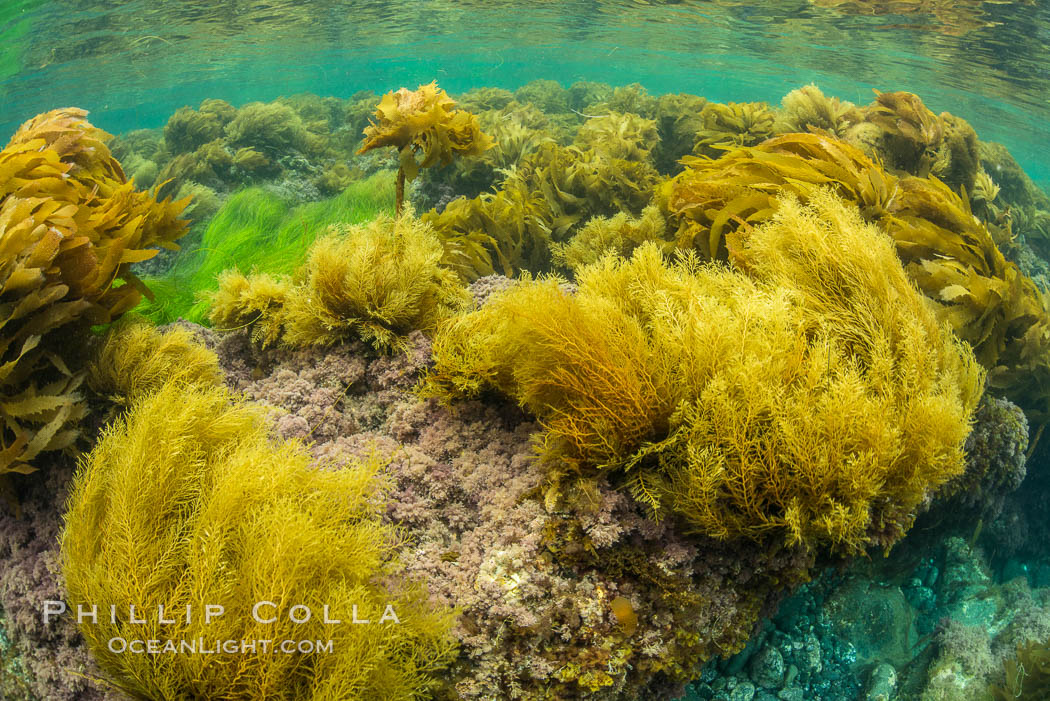I dive in Southern California and Baja California, and one of the most appealing things about the underwater landscapes I see are the many species of marine algae. Marine algae cover the reefs in most places with a lush, colorful, vibrant carpet of life. Following are photos of some of the more common and beautiful forms of marine algae found underwater along the Pacific coast of Southern California and Baja California. Descriptions are from Wikipedia. This is not meant to be a comprehensive list of all marine algae, nor is it meant to be an identification guide — it is simply to show the variety and beauty of my favorite types of marine algae. Thank you to Dr. Kathy Ann Miller of UC Berkeley for help in identification, any errors are strictly mine. Cheers and thanks for looking!
Giant Kelp, Macrocystis pyrifera
Macrocystis pyrifera, commonly known as giant kelp or giant bladder kelp, is a species of kelp (large brown algae), and one of four species in the genus Macrocystis. Giant kelp is common along the coast of the eastern Pacific Ocean, from Baja California north to southeast Alaska, and is also found in the southern oceans near South America, South Africa, and Australia. Individual algae may grow to more than 45 metres (148 ft) long at a rate of as much as 2 feet (61 cm) per day. Giant kelp grows in dense stands known as kelp forests, which are home to many marine animals that depend on the algae for food or shelter.
Kelp frond showing pneumatocysts.
Image ID: 00627
Species: Giant kelp, Macrocystis pyrifera
Location: San Clemente Island, California, USA
A kelp forest. Giant kelp grows rapidly, up to 2′ per day, from the rocky reef on the ocean bottom to which it is anchored, toward the ocean surface where it spreads to form a thick canopy. Myriad species of fishes, mammals and invertebrates form a rich community in the kelp forest. Lush forests of kelp are found through California’s Southern Channel Islands.
Image ID: 23428
Species: Giant kelp, Macrocystis pyrifera
Location: San Clemente Island, California, USA
A view of an underwater forest of giant kelp. Giant kelp grows rapidly, up to 2′ per day, from the rocky reef on the ocean bottom to which it is anchored, toward the ocean surface where it spreads to form a thick canopy. Myriad species of fishes, mammals and invertebrates form a rich community in the kelp forest. Lush forests of kelp are found through California’s Southern Channel Islands.
Image ID: 25400
Species: Giant kelp, Macrocystis pyrifera
Location: San Clemente Island, California, USA
Kelp holdfast and substrate.
Image ID: 00622
Species: Giant kelp, Macrocystis pyrifera
Location: San Clemente Island, California, USA
Feather Boa Kelp, Egregia menziesii
Egregia menziesii is a species of kelp known commonly as feather boa kelp. It is native to the coastline of western North America from Alaska to Baja California, where it is a common kelp of the intertidal zone. It is dark brown in color, shiny and bumpy in texture, and may reach over five meters long. It grows a branching stipe from a thick holdfast. It bears long, flat, straplike fronds lined with small blades each a few centimeters long. There are pneumatocysts at intervals along the fronds which provide buoyancy. The alga varies in morphology; the rachis, or central strip, of the frond may be smooth or corrugated, and the blades along the edge of the rachis may be a variety of shapes.
Feather boa kelp (long brown fuzzy stuff) and other marine algae cover the rocky reef.
Image ID: 25416
Species: Feather boa kelp, Egregia menziesii
Location: San Clemente Island, California, USA
Southern Sea Palm, Palm Kelp, Eisenia arborea
Eisenia arborea, or the southern sea palm (not to be confused with the sea palm), is a dominant species of kelp that is found in the Northern and Eastern Pacific from Vancouver Island, Canada south to Isla Magdalena, Mexico, and along the coast of Baja California. They are commonly found from the midtidal areas stretching to the subtidal areas. It is an edible seaweed, a source of nutrients for grazing marine invertebrates and a source of alginic acid, a food thickener. Some of the algas have a hollow stripe above its holdfast with two branches terminating in multiple blades. Eisenia arborea is studied in order to predict environmental stress in oceans intertidal zones. Hollow stripes where present when the Eisenia arborea did not receive essential nutrients for its thalli development. Eisenia arborea with hollow stripes are believed to be evolved algae in order to increase their survival in harsh living conditions. They play a huge role in determining environmental stress.
Southern sea palm, palm kelp, underwater, San Clemente Island.
Image ID: 30919
Species: Southern sea palm, Eisenia arborea
Location: San Clemente Island, California, USA
Southern sea palm, palm kelp, underwater, San Clemente Island.
Image ID: 30917
Species: Southern sea palm, Eisenia arborea
Location: San Clemente Island, California, USA
Southern sea palm.
Image ID: 09537
Species: Southern sea palm, Eisenia arborea
Location: Guadalupe Island (Isla Guadalupe), Baja California, Mexico
Palm kelp. Southern sea palm.
Image ID: 01249
Species: Southern sea palm, Eisenia arborea
Location: Guadalupe Island (Isla Guadalupe), Baja California, Mexico
Kelp covered wall of Isla Afuera, diver.
Image ID: 03724
Species: Southern Sea Palm, Eisenia arborea
Location: Guadalupe Island (Isla Guadalupe), Baja California, Mexico
Phyllospadix is a genus of seagrass or surfgrass, a flowering plant in the family Zosteraceae, described as a genus in 1840. Phyllospadix grows in marine waters along the coasts of the temperate North Pacific. It is one of the seagrass genuses that can perform completely submerged pollination.
Surfgrass (Phyllospadix), shallow water, San Clemente Island.
Image ID: 30941
Species: Surfgrass, Phyllospadix
Location: San Clemente Island, California, USA
Surfgrass and diver.
Image ID: 03736
Species: Surfgrass, Phyllospadix
Location: Guadalupe Island (Isla Guadalupe), Baja California, Mexico
Surfgrass (Phyllospadix), shallow water, San Clemente Island.
Image ID: 30886
Species: Surfgrass, Phyllospadix
Location: San Clemente Island, California, USA
Asparagopsis taxiformis, red marine algae, growing on underwater rocky reef below kelp forest at San Clemente Island.
Image ID: 30939
Species: Asparagopsis taxiformis
Location: San Clemente Island, California, USA
Various kelp and algae, shallow water.
Image ID: 21376
Species: Asparagopsis taxiformis
Location: Guadalupe Island (Isla Guadalupe), Baja California, Mexico
Garibaldi and Asparagopsis taxiformis (red marine algae), San Clemente Island
Image ID: 30881
Species: Garibaldi, Hypsypops rubicundus, Asparagopsis taxiformis
Location: San Clemente Island, California, USA
Stephanocystis is characterized by highly differentiated basal and apical regions and the presence of catenate pneumatocysts (air-vesicles). In Stephanocystis old plants have an elongated main axis, and in time the primary laterals become proportionally elongated. Their lower parts are strongly flattened into ‘foliar expansions’ or basal leaves. Fertile regions which bear conceptacles are known as receptacles. These are normally found at the tips of the branches. Their basal and apical regions are highly differentiated. They have catenate pnuematocysts (air vesicles). The aerocyst or air vesicles keep the organism erect, by causing it to float in strong currents.
A group of juvenile and female Guadalupe fur seals rest and socialize over a shallow, kelp-covered reef. During the summer mating season, a single adjult male will form a harem of females and continually patrol the underwater boundary of his territory, keeping the females near and intimidating other males from approaching.
Image ID: 09677
Species: Guadalupe fur seal, Arctocephalus townsendi, Stephanocystis dioica
Location: Guadalupe Island (Isla Guadalupe), Baja California, Mexico
Stephanocystis dioica (yellow) and surfgrass (green), shallow water, San Clemente Island
Image ID: 30946
Species: Surfgrass, Phyllospadix, Stephanocystis dioica
Location: San Clemente Island, California, USA
Stephanocystis dioica (lighter yellow), southern sea palm (darker yellow) and surfgrass (green), shallow water, San Clemente Island
Image ID: 30948
Species: Southern palm kelp, Surfgrass, Eisenia arborea, Phyllospadix, Stephanocystis dioica
Location: San Clemente Island, California, USA
